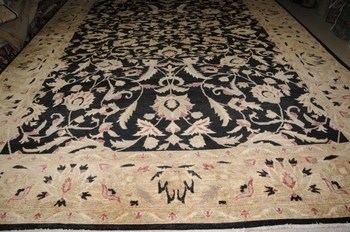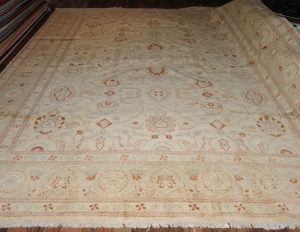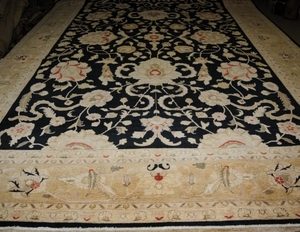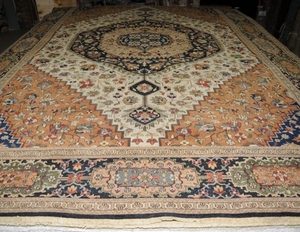Description
Our oversize Mahal rug is a stunning example of Persian craftsmanship. Hand-knotted from the finest Persian wool, this rug features intricate designs and a luxurious feel. The classic patterns and soft colors make it a timeless addition to any home.
Mahal rugs, with their intricate designs, luxurious materials, and rich history, are more than just floor coverings. They are tangible expressions of Persian culture, reflecting the nation’s artistic traditions, religious beliefs, and historical events.
Symbol of Status and Wealth:
- Royal Connection: Mahal rugs were often associated with royalty and the Persian aristocracy. Their intricate designs and high-quality materials were seen as symbols of status and wealth.
- Palace Decorations: These rugs adorned the palaces and residences of Persian rulers, showcasing the opulence and grandeur of the empire.
Characteristics of the Symmetrical Knot:
- Density: The symmetrical knot creates a dense and durable rug with a thick pile.
- Symmetry: As the name suggests, the knot is symmetrical, meaning the warp and weft threads are wrapped around each other in a balanced manner.
- Ease of Weaving: This knot is relatively easy to weave, making it a popular choice for rug makers.
Other Knot Types (Less Common in Mahal Rugs):
While the symmetrical knot is the primary knot used in Mahal rugs, other knot types may occasionally be found, especially in older or more intricate designs:
- Persian Knot: Also known as the Ghiordes knot, this knot is slightly larger than the symmetrical knot and produces a slightly looser weave.
- Senneh Knot: This knot is smaller than the symmetrical knot and creates a very dense rug with a fine texture.
Factors Affecting Knot Type:
- Design Complexity: More intricate designs may require the use of different knot types to achieve specific patterns or textures.
- Regional Variations: Different regions within Persia may have had their own preferred knot types or techniques.
- Historical Period: The type of knot used could vary depending on the historical period and the prevailing weaving styles.
In conclusion, while the symmetrical knot is the most common and characteristic knot used in Mahal rugs, other knot types may occasionally be found, depending on various factors. The choice of knot type can influence the density, texture, and overall appearance of the rug.
Specific Care for Mahal Rugs
To preserve the beauty and durability of a Mahal rug, it is important to follow some care guidelines:
- Regular vacuuming: Vacuum your Mahal rug regularly to remove dust and dirt. Use the appropriate nozzle to avoid damaging the fibers.
- Avoid direct sunlight: Direct sunlight can discolor the colors of your rug. Place it in a location protected from sunlight.
- Professional cleaning: Mahal rugs should be professionally cleaned every so often. A specialized rug cleaner can determine the best cleaning method for your rug.
- Avoid stains: Clean any stains as soon as possible using a clean cloth and cold water. Avoid rubbing the stain, as this can damage it.
- Protect the edges: Place doormats at entrances to prevent dirt from adhering to the edges of your rug.
At Shahrian, we are committed to providing our customers with the highest quality oriental rugs. Our extensive selection of Mahal rugs includes a variety of sizes, colors, and designs. In addition to sales, we also offer professional rug cleaning and restoration services.





